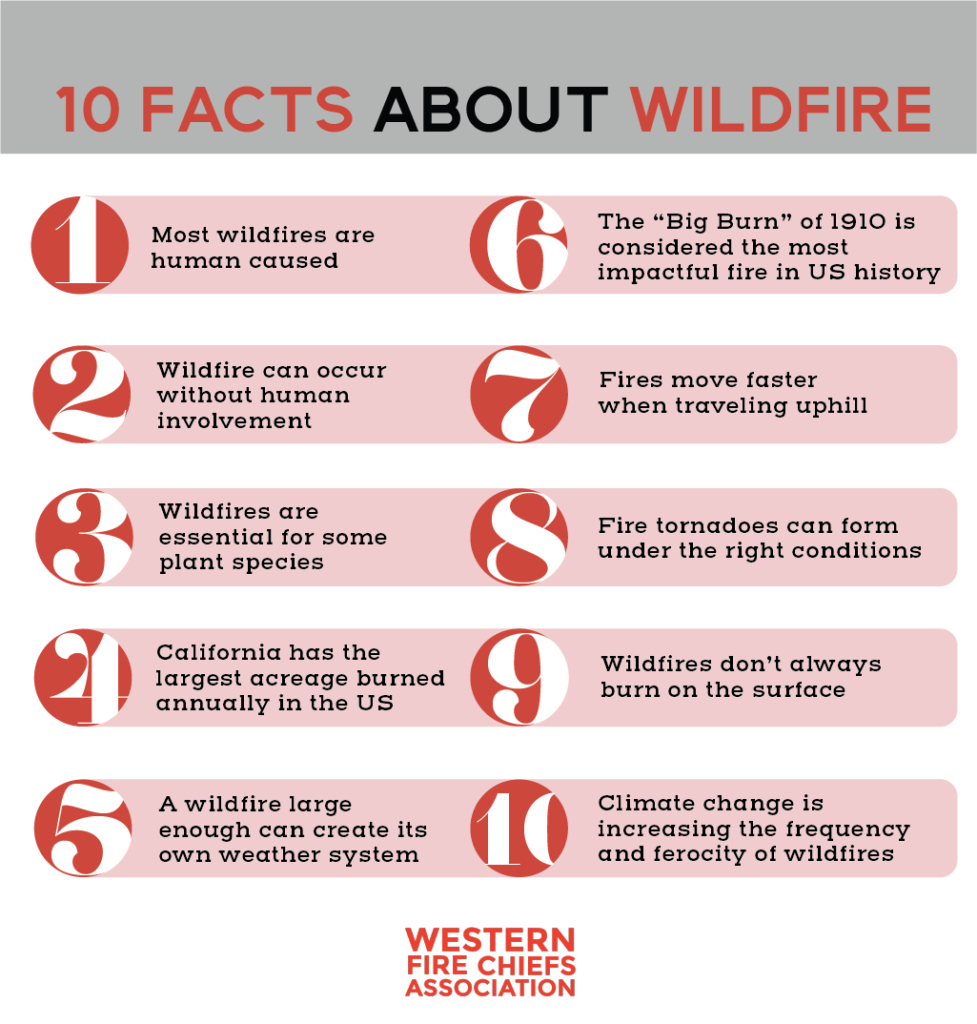Fire Pit Safety Tips
Stay safe around the campfire with tips from the Western Fire Chiefs Association. Learn essential precautions and practices for a worry-free outdoor campfire.
Since 2012, wildfires have burned an annual average of 7.4 million acres across the United States. Read on to learn ten interesting facts about wildfires from the Western Fire Chiefs Association (WFCA).
Published:July 6, 2022
Edited:April 24, 2024

Did you know that since 2012, wildfires have burned an annual average of 7.4 million acres across the United States1? How about that fires burn faster going uphill, or that they can create their own weather? These are just a few facts about wildfires to be aware of as climate change makes them increasingly more likely to occur. Read on to discover interesting facts about wildfires from the Western Fire Chiefs Association (WFCA).
Humans cause nearly 90% of all wildfires in the US2, usually as a result of carelessness. One abandoned cigarette or improperly extinguished barbecue can have devastating consequences, and extra caution is always warranted when fire risk conditions are high.
Lightning strikes are a relatively common way for wildfires to start. According to the National Fire Protection Agency, between 2007-2011, “U.S. local fire departments responded to an estimated average of 22,600 fires per year that were started by lightning”3.
There are certain species of plants that have evolved to depend on wildfires for their continued survival. As described in National Geographic Encyclopaedia, some tree cones need heat before they can release their seeds. Other plants, such as scrub oak, need fire for their seeds to germinate. Some plants need fire every few years, whereas others only require it every few decades for survival4.
California, the third-largest state in the US, has the most annual acres burned by wildfire. While California is the most prone to wildfires, there are many other states that have frequent and devastating wildfires. Second on the list is Oregon, followed by Washington5.
An astonishing fact about wildfire is that once a wildfire reaches a certain size, the smoke and heat it emits can create what is known as a fire cloud or a pyrocumulonimbus. Fire clouds are especially dangerous as they can hurl lightning bolts, wind, rain, and burning embers down towards the ground. NASA has called these clouds the “fire-breathing dragon of clouds,” because they often worsen fire conditions and feed the process of destruction.6

The “Big Burn, or “Big Blowup” of 1910 is widely considered one of the worst fires in US history. This collection of fires killed 84 people and destroyed more than 3 million acres of land in Idaho, Montana, and Washington over the course of just a few days. Taking place only five years after the establishment of the US Forest Service, this catastrophe cemented the agency’s mission to ‘eliminate fire from the landscape’, a problematic and largely unscientific approach that continues to influence fire policy and management to this day.7
The landscape has powerful effects on how fire behaves. For example, wildfires tend to spread faster uphill than downhill. Because heat rises, a fire going uphill dries out and preheats the vegetation ahead of it.8 Wind is another contributing factor. Fires are typically most active during the day when conditions are warmer and wind tends to blow uphill.
Another weather system that wildfires sometimes create are tornados. This happens when intense rising heat and turbulent wind conditions combine to create a tornado-like vortex that sucks in debris and combustible gases. Otherwise known as a ‘fire whirl’ they can reach temperatures of up to 1090 °C.9
If organic matter has accumulated underground over time, it is possible for a fire to burn and spread below the surface terrain with little to no visible evidence. ‘Ground fires’, also called ‘sub-surface fires’, are notoriously difficult to extinguish and can burn for months or even years.
‘Crown fires’ can happen during strong wind events, spreading fire through the tree canopy. These fires can be especially dangerous because they can burn hotter, spread faster, and change direction more rapidly than other types of wildfire.
The average length of wildfire season in the US has increased from four months to as long as eight months due to climate change, and may eventually last year-round.10 Rising temperatures and more frequent heatwaves are causing longer periods of drought which produces drier vegetation. When coupled with an increase in lightning storms and high wind events, wildfires are becoming more frequent, and data show they burn faster and spread further than historical trends.
Stay safe around the campfire with tips from the Western Fire Chiefs Association. Learn essential precautions and practices for a worry-free outdoor campfire.
Discover essential firework safety tips to ensure a dazzling display without accidents. Learn how to celebrate responsibly with expert guidance from WFCA.
Explore the role of AI in wildfire prediction with guidance from the WFCA. Learn how advanced algorithms and data analytics enhance early detection and response.